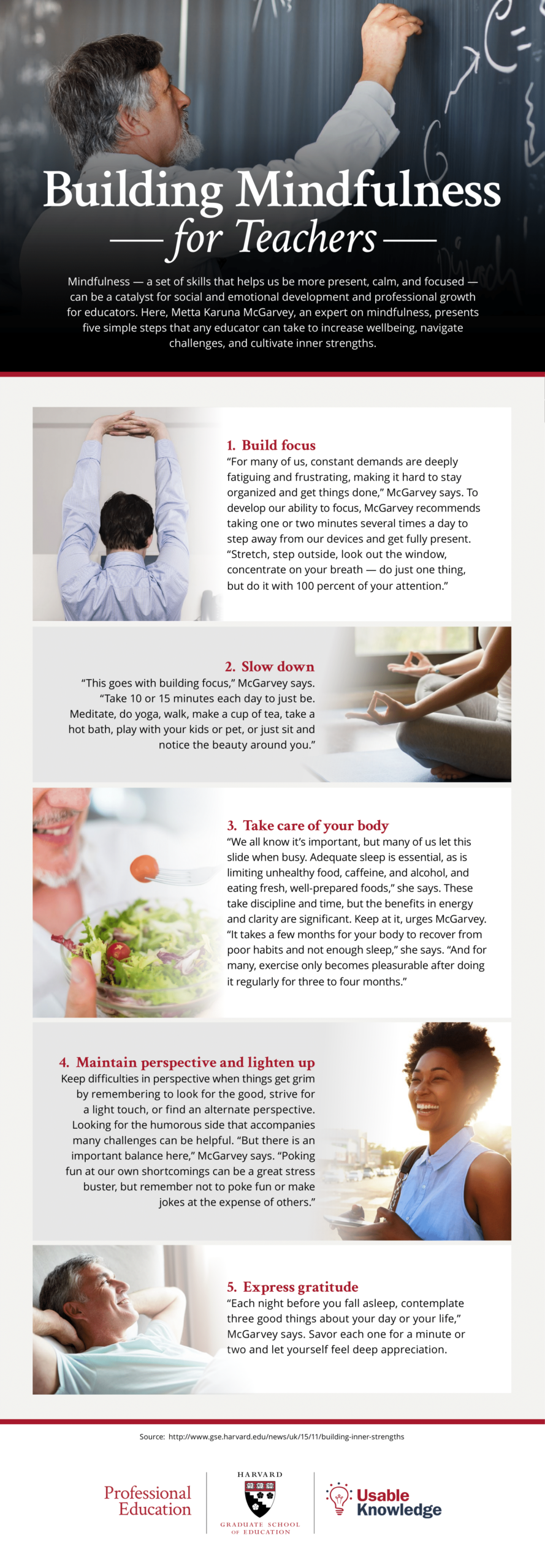
“Building Mindfulness For Teachers Guide from Professional Education at the Harvard Graduate School of Education” https://www.gse.harvard.edu/ppe
A teacher’s life is full of stress from macro-ones (a standardized assessment) and micro-ones (a student interrupts you again). Under stress, we sometimes react by metaphorically fighting, freezing, or fleeing. However, we can also choose to respond intentionally to the situation rather than having a knee-jerk reaction.
My 9-minutes mindfulness meditation practice before I leave my house builds my response-muscle so that I can be in charge of my emotions when stressed, think clearly and act professionally to students and colleagues. I have almost zero control of what happens in the day, but I have 100% control of how I respond.
Areas where mindfulness can support teachers
My mindfulness practice has helped me tremendously in all aspect of my teaching career simply because I am more aware of them. Below is a list of categorized ways my mindfulness practice has helped me slow down and take notice:
Collaboration
- Notice the emotional state of my colleagues
- Stay open to opportunities to collaborate
- Look for chances to praise and compliment colleagues
- Be sensitive to their triggers
- Find ways to leverage their strengths
- Notice when backing off is more appropriate to reach the long-term goals
- Recognize emotional, behavioral, cognitive patterns
- Be aware of the self-talk I have about my colleagues
- Observe my tone, body language, and judgment-loaded language
Curriculum
- Notice the appropriate sequencing of learning experiences
- Consider the developmentally-appropriateness of the learning experiences
- Recognize opportunities for interdisciplinary learning
- Be aware when inquiry or direct instruction is more appropriate
- Pay attention to the content and language objectives
- Think about the accessibility of the resources
- Continuously reference assessment criteria
Instruction
- Remember to avoid sarcasm
- Be alert of over scaffolding and enabling behavior
- Find ways to build background knowledge
- Notice the level of clarity of the instructions
- Recognize when modeling is needed
- Be aware of the providing steps and to model
- Observe students who I’m calling on or not
- Noticing how we are managing students
Students
- Be aware of students’ emotional state
- Notice moments to celebrate their achievement
- Remember their strengths and area of growth
- Be conscious of their triggers and sensitive topics
- Pay attention to how students are treating each other
- Find ways for students to comprehend the content
- Offer alternative ways for students to demonstrate understanding
- Be conscious of moments of praising their mindset and thinking vs their personality
These lists are not exhaustive. However, the items in these categories are things we must pay attention to. Mindfulness doesn’t mean we are zenned out at our teacher’s desk and allow for students to run amuk. Mindfulness in teaching means two things:
- To be in control of our actions rather than responding impulsively
- Being in the moment enough to attend to the needs of colleagues, students, curriculum, and ourselves
Resources on starting your own mindfulness practice
There is an extensive community of mindfulness practitioners that can offer ways for you to establish your own mindfulness practice. Below are some resources you might find useful:
- Book: The Little Book of Mindfulness
- Podcast: Tara Brach
- Apps with guided meditation tracks: Headspace, Calm
Because a day at school whizzes by, with my mindfulness practice, I have a one-second window when I can choose to respond intentionally rather than being tossed around by my emotions. Maybe that extra a second before I react is enough to stop me from reacting in a way that I would later regret. I subscribe to the mantra that regret weighs a ton but discipline weight ounces.
I would not be the teacher that I am today without my mindfulness practice. I would be a teacher that stumbles through the days as opposed to an educator that (in the best moments) feels the weight of each step taken.

